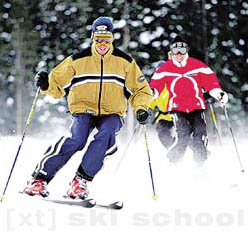|
Flexion and Extension
All movements in skiing are progressive. This is what makes good skiers look like they are floating along as soft as an airborne feather. The skier starts out with a tall stance and gracefully moves into an angulated position. The steeper the terrain the more the body must be angulated to match the gradient. Think of every turn as a separate starting point. The skier must start out tall and gradually angulate the body as the forces of gravity and centrifical force act on the body. The angulated position seems to an observer as if you are lowering yourself.
The tall stance is called the extension phase of the turn. It is during this phase that the body is straightened while initiating the next turn. It is important to understand that the body has to be straightened at the beginning of every turn. It is at the top of the extension that the wrist can bring the pole forward for the touch. As the body starts to sink down for the flexion, the pole moves back with the turn.
While into the first 20% of the turn, the body should start to flex forward, by bending the ankles and knees and dropping the hips into the hill all the while keeping a downward intention (open the hip to the downhill side). The pole touch is directly linked with the flexion and extension. As the body is flexed the pole can't come forward without raising the arm position, but as the body straightens, the pole can come forward with a slight movement of the wrist.
The softer the movements are made to look, the better you are perceived to be. A good smooth looking turn is light on the edges and soft with the pole touch. These movements will make a picture perfect turn and make the turn efficient and fast if taken into the race course.
Alpine Skiing School section in english version of WWW.SKI.BG is based on
"A Guide To Becoming An Expert: From First Time To A Lifetime"
by John Mukavitz Copyright © 1998

|


